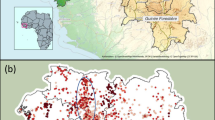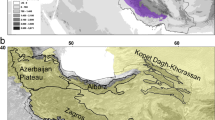Abstract
Seventeen European endemic plant species were considered extinct, but improved taxonomic and distribution knowledge as well as ex situ collecting activities brought them out of the extinct status. These species have now been reported into a conservation framework that may promote legal protection and in situ and ex situ conservation.
This is a preview of subscription content, access via your institution
Access options
Access Nature and 54 other Nature Portfolio journals
Get Nature+, our best-value online-access subscription
$29.99 / 30 days
cancel any time
Subscribe to this journal
Receive 12 digital issues and online access to articles
$119.00 per year
only $9.92 per issue
Buy this article
- Purchase on Springer Link
- Instant access to full article PDF
Prices may be subject to local taxes which are calculated during checkout
Similar content being viewed by others
Data availability
All data and sources of data (including links) used in the manuscript have been reported in the reference list or in Table 1.
References
Guidelines for Using the IUCN Red List Categories and Criteria Version 14 (IUCN Standards and Petitions Committee, 2019); http://www.iucnredlist.org/documents/RedListGuidelines.pdf
Dalrymple, S. E., Godefroid, S., Orsenigo, S. & Abeli, T. Frankenstein’s work or everyday conservation? How reintroductions are informing the de-extinction debate. J. Nat. Conserv. 56, 125870 (2020).
IUCN SSC. Guiding Principles on Creating Proxies of Extinct Species for Conservation Benefit Version 1.0 (IUCN, 2016).
Dalrymple, S. E. & Abeli, T. Ex situ seed banks and the IUCN Red List. Nat. Plants 5, 122–123 (2019).
Humphreys, A. M., Govaerts, R., Ficinski, S. Z., Lughadha, E. N. & Vorontsova, M. S. Global dataset shows geography and life form predict modern plant extinction and rediscovery. Nat. Ecol. Evol. 3, 1043–1047 (2019).
Knapp, W. M. et al. Regional records improve data quality in determining plant extinction rates. Nat. Ecol. Evol. 4, 512–514 (2020).
Ladle, R. J., Jepson, P., Malhado, A. C. M., Jennings, S. & Barua, M. The causes and biogeographical significance of species’ rediscovery. Front. Biogeogr. 3, 111–118 (2011).
Scheffers, B. R., Yong, D. L., Harris, J. B. C., Giam, X. & Sodhi, N. S. The world’s rediscovered species: back from the brink? PLoS ONE 6, e22531 (2011).
Aedo, C., Medina, L., Barberá, P. & Fernández-Albert, M. Extinctions of vascular plants in Spain. Nord. J. Bot. 33, 83–100 (2015).
Bawri, A., Gajurel, P. R. & Khan, M. L. Rediscovery of Primula polonensis. Kew Bull. 70, 56–60 (2015).
Bonini, F., Lastrucci, L. & Gigante, D. Juncus atratus Krock. (Juncaceae) rediscovered in Italy: a species deserving urgent conservation actions. Biologia 75, 1519–1527 (2020).
Abeli, T. et al. Ex situ collections and their potential for the restoration of extinct plants. Conserv. Biol. 34, 303–313 (2020).
Liu, U., Breman, E., Cossu, T. A. & Kenney, S. The conservation value of germplasm stored at the Millennium Seed Bank, Royal Botanic Gardens, Kew, UK. Biodivers. Conserv. 27, 1347–1386 (2018).
Minteer, B. A., Collins, J. P., Love, K. E. & Puschendorf, R. Avoiding (re)extinction. Science 344, 260–261 (2014).
Rossi, G. et al. Is legal protection sufficient to ensure plant conservation? The Italian Red List of policy species as a case study. Oryx 50, 431–436 (2016).
Fos, S., Laguna, E., Jiménez, J. & Gómez-Serrano, M. Á. Plant micro-reserves in Valencia (E. Spain): a model to preserve threatened flora in China? Plant Divers. 39, 383–389 (2017).
Keith, D. A. & Burgman, M. A. The Lazarus effect: can the dynamics of extinct species lists tell us anything about the status of biodiversity? Biol. Conserv. 117, 41–48 (2004).
Dunkel, F. G. The Ranunculus auricomus L. complex (Ranunculaceae) in northern Italy. Webbia 65, 179–227 (2010).
Bartolucci, F. et al. An updated checklist of the vascular flora native to Italy. Plant Biosyst. 152, 179–303 (2018).
Lista Vermelha da Flora Vascular de Portugal Continental (Sociedade Portuguesa de Botânica e Associação Portuguesa de Ciência da Vegetação – PHYTOS, em parceria com o Instituto da Conservação da Natureza e das Florestas, 2020); https://listavermelha-flora.pt/
Euro+Med PlantBase—the Information Resource for Euro-Mediterranean Plant Diversity (Euro+Med, 2020); http://ww2.bgbm.org/EuroPlusMed/
Perehrym, M. M. in Vascular Plants of the Emerald Network of Ukraine Under Protection of the Bern Convention (ed. Solomakha, V. A.) (Ministry of Ecology and Natural Resources of Ukraine, 2016).
Andrés-Sánchez, S., Galbany-Casals, M., Rico, E. & Martínez-Ortega, M. M. A nomenclatural treatment for Logfia Cass. and Filago L. (Asteraceae) as newly circumscribed: typification of several names. Taxon 60, 572–576 (2011).
Vladimirov, V., Aybeke, A., Matevski, V. & Tan, K. New floristic records in the Balkans: 33*. Phytol. Balc. 23, 281–329 (2017).
Orsenigo, S. et al. Red list of threatened vascular plants in Italy. Plant Biosyst. 152, 310–335 (2021).
Barina, Z. (ed.) Distribution Atlas of Vascular Plants in Albania (Hungarian Natural History Museum, 2017).
La Liste Rouge des Espèces Menacées en France—Chapitre Flore Vasculaire de France Métropolitaine (UICN France, FCBN, AFB, MNHN, 2018).
Blanca, G., Gavira, O. & Suárez-Santiago, V. N. Galatella malacitana (Asteraceae): a new species from the peridotitic mountains of southern Spain. Phytotaxa 205, 239–248 (2015).
Bogdanović, S., Brullo, S., Ljubičić, I., Rat, M. & Salmeri, C. Cytotaxonomical remarks on Loncomelos visianicum (Hyacinthaceae), a poorly known species endemic to Croatia. Phytotaxa 430, 95–108 (2020).
Banfi, E. in Flora d’Italia 2nd edn, Vol. 1 (eds Pignatti, S. et al.) (Edagricole, 2017).
Acknowledgements
We thank the following colleagues for providing important information on one or more species: S. Sharrock (Botanic Garden Conservation International), M. Nickols (Botanic Garden of Kiel University, Germany), E. von Raab-Straube (University of Berlin, Germany), J.-M. Tison (L’Isle d’Abeau, France), R. Cubey (Royal Botanic Garden Edinburgh, Scotland), P. Harvey (Shetland Amenity Trust, Scotland), M. C. Villani (Padua Botanic Garden, Italy), M. Vidali and F. Martini (University of Trieste, Italy), D. Viciani (University of Firenze, Italy), G. Domina (University of Palermo, Italy), G. P. Giusso del Galdo (University of Catania, Italy), E. Banfi (Natural History Museum of Milan, Italy), R. Jaén-Molina (Jardín Botánico Canario ‘Viera y Clavijo’—UA-CSIC, Gran Canaria, Spain), R. Gabriel (University of the Azores, Portugal), S. Sá Fontinha (Regional Secretariat for Environment and Natural Resources, Madeira, Portugal), C. Freitas (Regional Secretariat of Energy, Environment and Tourism, Azores, Portugal), E. J. Gouda (Utrecht University Botanic Gardens, Netherlands), C. Gomes (National Museum of Natural History and Science, Portugal), G. Nieto Feliner (Real Jardín Botánico—CSIC, Madrid, Spain), I. Marques (University of Lisbon, Portugal), S. Bogdanovic (University of Zagreb, Croatia), A. Efremov (Omsk, Russia), V. M. Ostapko (Donetsk Botanic Garden, Ukraine), A. Gnatiuk (M. M.Gryshko National Botanical Garden, National Academy of Sciences of Ukraine, Ukraine) and A. Strid (Denmark). We thank the Grant of Excellence Departments, MIUR-Italy (ARTICOLO 1, COMMI 314 – 337 LEGGE 232/2016), for supporting one of the authors (T.A.).
Author information
Authors and Affiliations
Contributions
T.A. and G.A.R. conceived the idea and wrote the manuscript. Z.B. reviewed the species for Hungary, Ukraine and the Balkans. I.B. reviewed the species for Greece. D.D. reviewed the species for Portugal and revised the material of A. arcuata. P.G. reviewed the species for France. J.M.I., E.L. and J.C.M.-S. reviewed the species for Spain and the Azores. F.B. reviewed the species for Italy, Malta and Croatia and revised the taxonomy. All authors contributed to the several versions of this manuscript, including the design of Table 1.
Corresponding author
Ethics declarations
Competing interests
The authors declare no competing interests.
Additional information
Peer review information Nature Plants thanks Richard Olmstead and the other, anonymous, reviewer(s) for their contribution to the peer review of this work.
Publisher’s note Springer Nature remains neutral with regard to jurisdictional claims in published maps and institutional affiliations.
Supplementary information
Rights and permissions
About this article
Cite this article
Abeli, T., Albani Rocchetti, G., Barina, Z. et al. Seventeen ‘extinct’ plant species back to conservation attention in Europe. Nat. Plants 7, 282–286 (2021). https://doi.org/10.1038/s41477-021-00878-1
Received:
Accepted:
Published:
Issue Date:
DOI: https://doi.org/10.1038/s41477-021-00878-1
This article is cited by
-
Re-introduction of an extinct population of Pulsatilla patens using different propagation techniques
Scientific Reports (2022)
-
Out-of-date datasets hamper conservation of species close to extinction
Nature Plants (2022)
-
Selecting the best candidates for resurrecting extinct-in-the-wild plants from herbaria
Nature Plants (2022)
-
Genotype-dependent mass somatic embryogenesis: a chance to recover extinct populations of Pulsatilla vulgaris Mill.
Plant Cell, Tissue and Organ Culture (PCTOC) (2021)



